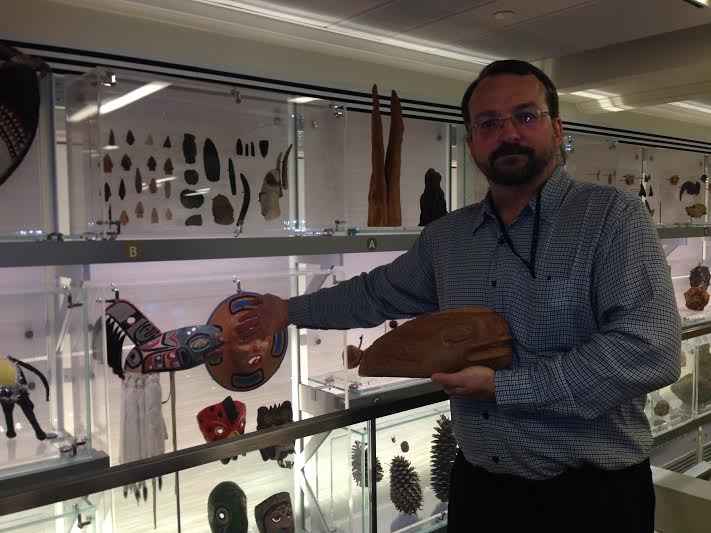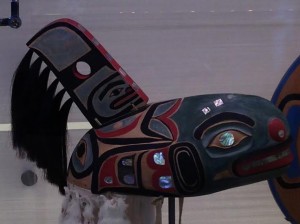WASHINGTON – Scientists have used 3-D printing to replicate everything from robots to food. Now, they’re using the technology to help preserve a culture.
Eric Hollinger, an archaeologist at the Smithsonian National Museum of Natural History’s Repatriation Office, has partnered with Native American tribes to 3-D digitize artifacts for preservation and educational purposes. Last year, the museum replicated a more than 110-year-old wooden hat used by the Tlingit Dakl’aweidi clan of southeast Alaska. The clan gave the museum permission to include it in Q?rius, a space designed to engage students with science.
Now, Hollinger and his team, in cooperation with the Hoonah Indian Association, are planning to replicate more than 30 Tlingit items that had been repatriated, or given back to the tribes from the museum, which had owned them. At a museum event Thursday, Hollinger talked about the new project and its impact on the museum and Native Americans.
JA: Can you talk about why the museum has partnered with tribes for these projects?
EH: 3-D replication has been around a long time and used in lots of engineering contexts, but for Native American cultures, and particularly in the context of repatriation….it allows additional options to be exercised by the museum and by the tribe in that context in that tribes often want to rebury objects that might be funerary objects or human remains. This allows them to make copies in some form or at least even 3-D digital copies they might want on the Web that they can have control over, that they can use to teach future generations.
JA: How many items have you replicated using 3-D technology?
EH: The first one we did was a pipe with the Delaware and Stockbridge-Munsee, and they made four copies in that case of one object so we could share those copies with each tribe involved, and the museum retained one. … And the biggest one we did was the Killer Whale Hat, where we just made one copy. …Now, the project that we’re involved in is with the Hoonah, the Tlingit village of Hoonah, Alaska. There are 53 objects we repatriated and there’s probably going to be about 33 that we’re going to try to reproduce. And the agreement we have with them is that they want one set of reproductions for themselves to teach with and replicate and display to people, and they’re allowing us to make a copy we can retain here.
JA: How did the idea to replicate these items come about?
EH: The first project was with the pipes – the Delaware and Stockbridge-Munseetribes was repatriating human remains from using them and this pipe, which was a funerary object. Right before the repatriation, one of the representatives knew we had this technology and so she asked if we could make it into a 3-D print and we did, but we had to rush it.
With the Killer Whale hat from the Tlingit in Alaska, that was being returned as a sacred object and an object of cultural patrimony that they used in ceremonies. …They were also aware of the technology that we were beginning to employ in different areas of the Smithsonian, and they recognized that if we were to laser scan the hat we could make a very good digital file that would in a sense serve as security, as an archival copy. That naturally led to discussions of whether they would let us make a replica to use for exhibits here – that’s what they ultimately agreed to do and it kind of evolved.
As we go into this age of digital technology, one of the greatest things that they’ve been concerned about with this is that they see this and say it makes it very easy to reproduce something. That scares [them] because how do we prevent that from landing in the hands of commercial enterprises and people making Killer Whale key chains and mass producing them and putting them on shelves. They don’t want that. They are very protective of their intellectual property rights.
JA: Can you talk about the objects you’ve replicated in the newest project with the Tlingit?
EH: These are Shaman’s funerary objects. …They would have been used in their healing practices. And they had spirits in the objects – a lot of the healing dealt with spirits. But they’re also very powerful and very dangerous. And so the original objects can be rather taboo to handle or to access. …Sometimes they don’t want to be near the originals. And so this opens up that potential – so they could rebury them like funerary objects or they might want to sequester them in other ways so people aren’t exposed to those.
JA: Are there other museums doing similar things?
EH: Not as far as we know. Not with objects involved in repatriation. One tribe told us that after they came and saw what we are doing here, then they went home and got things repatriated from another museum and went to their local university and had things 3-D replicated there. We didn’t know anything about that. As far as we know, people may be doing it now and certainly it appears that we’ve inspired other tribes to approach it and use it for their interests.


